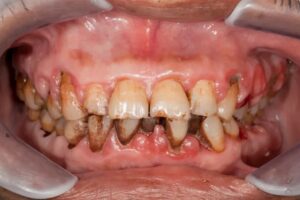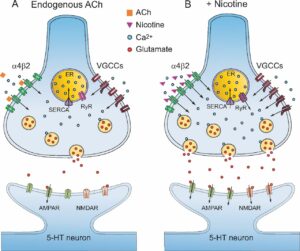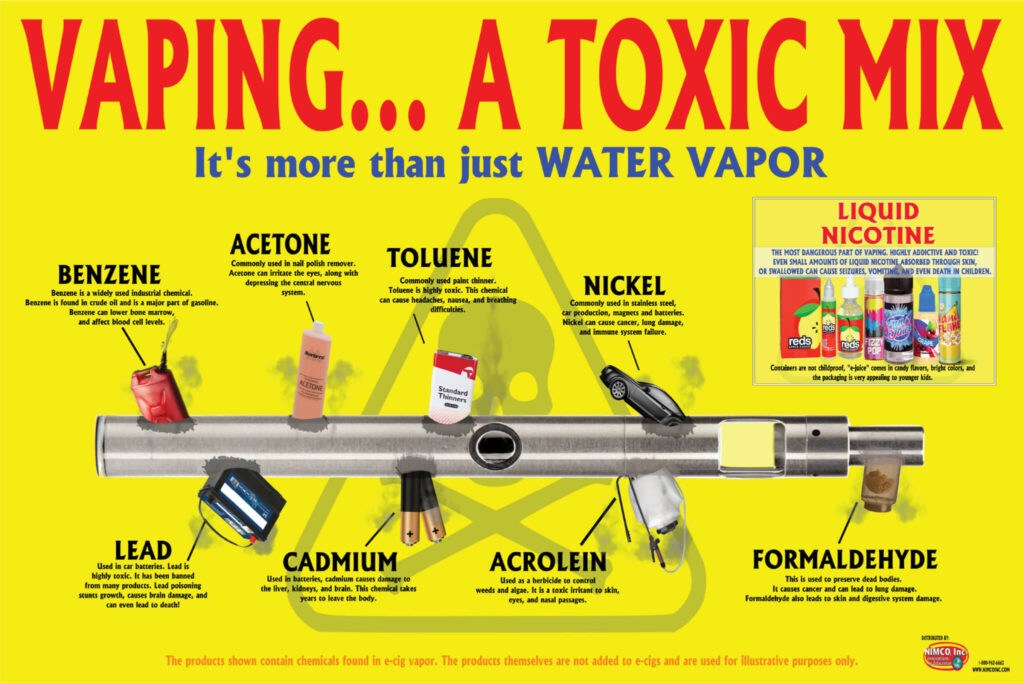The Rise of Vaping and Its Appeal
Vaping, the act of inhaling vaporized nicotine and other substances, has become particularly popular among youth. According to a study published in Critical Reviews in Toxicology, over 40% of high school seniors reported using e-cigarettes in the past year. This trend is not surprising, given the aggressive marketing tactics employed by vape companies. Flavors like mango, cotton candy, and mint, coupled with sleek, discreet designs, have made vaping an attractive option for young users. However, this perceived harmlessness is a dangerous misconception.
The Toxic Cocktail in Vapes
Vapes often contain a mix of nicotine, flavorings, and other chemicals. The aerosol produced during vaping contains toxic substances, including heavy metals like nickel, tin, and lead, as well as carcinogens such as formaldehyde and acetaldehyde. Studies have revealed that the chemical composition of vape juice can change during the vaping process, resulting in the formation of harmful byproducts like quinones and carbonyls.
The Impact on Fertility and Testosterone: A Deep Dive into “Manhood” and Vaping
The harmful substances in both vapes and cigarettes can have severe repercussions on reproductive health. For men, exposure to nicotine and other chemicals in these products can lead to a reduction in testosterone levels, adversely affecting sperm production and overall reproductive health. A study conducted on male albino rats exposed to e-cigarette vapor found significant reductions in serum testosterone levels and damage to the testes, including reduced sperm count and structural abnormalities.
For women, nicotine and other toxic substances can disrupt the menstrual cycle, potentially leading to irregular periods, reduced fertility, and even early menopause. A study published in Fertility and Sterility highlighted the risks associated with e-cigarette use during pregnancy, including increased chances of preterm birth and other complications. These risks extend to the developing fetus, potentially leading to long-term health issues.
Effects on Testicular Health and Structure
 Another study explored the effects of cigarette smoke and EC vapor on the male urogenital system, specifically focusing on testicular health. The study involved exposing adult male Wistar rats to cigarette and EC smoke in a controlled environment and comparing the results with a control group. The findings were alarming: both cigarette and EC exposure led to significant morphological changes in the testicles. Some rats exhibited disorganized seminiferous tubules, with germ cells and Sertoli cells separating and shedding. In severe cases, there was evidence of halted germ cell separation, cavity formation, necrosis, fibrosis, and testicular atrophy.
Another study explored the effects of cigarette smoke and EC vapor on the male urogenital system, specifically focusing on testicular health. The study involved exposing adult male Wistar rats to cigarette and EC smoke in a controlled environment and comparing the results with a control group. The findings were alarming: both cigarette and EC exposure led to significant morphological changes in the testicles. Some rats exhibited disorganized seminiferous tubules, with germ cells and Sertoli cells separating and shedding. In severe cases, there was evidence of halted germ cell separation, cavity formation, necrosis, fibrosis, and testicular atrophy.
These structural changes are not just cosmetic. The seminiferous tubules are essential for spermatogenesis—the process of sperm production. Damage to these structures can impair sperm production and quality, leading to decreased fertility. The study also found increased levels of oxidative stress markers, such as lipid peroxidation (LPO), in the testicular tissue of rats exposed to both cigarette and EC smoke. Oxidative stress can damage cellular components, including lipids, proteins, and DNA, further exacerbating the decline in reproductive health.
Testosterone Levels and “Manhood”
Testosterone is a crucial hormone for male reproductive health, affecting everything from sperm production to libido. Reduced testosterone levels can lead to symptoms such as decreased sex drive, erectile dysfunction, and even a reduction in testicular size, colloquially referred to as “shrinkage.” The before-mentioned study noted that exposure to EC and cigarette smoke could negatively impact testosterone levels, although the precise mechanisms are still under investigation.
The reduction in testosterone levels associated with vaping and smoking is likely due to several factors, including increased oxidative stress and damage to the Leydig cells in the testes, which are responsible for testosterone production. Additionally, nicotine and other toxic substances found in vape aerosols and cigarette smoke can interfere with the endocrine system, further disrupting hormone production and regulation.
Sperm Quality and Fertility
In terms of sperm quality, the study observed no significant differences between the control group and the groups exposed to cigarette and EC smoke concerning sperm count and motility. However, the structural damage to the testicles and increased oxidative stress suggest potential long-term effects on sperm quality and fertility. The absence of immediate differences in sperm parameters does not rule out future fertility issues, especially with continued exposure to harmful substances.
Previous studies have similarly highlighted the adverse effects of smoking on male fertility, linking it to chromatin damage, increased oxidative stress, and decreased sperm quality. These issues are compounded by the fact that oxidative stress disrupts the delicate balance between reactive oxygen species (ROS) and antioxidants in the body. This imbalance can lead to DNA damage in sperm, affecting their ability to fertilize an egg and potentially leading to infertility.
The Broader Health Implications
Beyond reproductive health, nicotine delivery systems pose numerous other risks. The inhalation of toxic substances from both vapes and cigarettes can lead to respiratory problems, cardiovascular disease, and compromised immune function. Nicotine addiction, regardless of the delivery method, can exacerbate stress and anxiety, creating a cycle of dependency that is difficult to break.

Furthermore, there is growing evidence that the chemicals found in e-cigarette vapor can cause damage to the oral cavity, including gum disease and tooth decay. The aerosol can also impair the function of endothelial cells, which play a crucial role in cardiovascular health. These findings suggest that even if vapes are less harmful than traditional cigarettes in some respects, they are far from safe.
The Misguided War on Nicotine
While the dangers of smoking and vaping are well-documented, nicotine itself has often been unjustly vilified. Nicotine is a naturally occurring alkaloid found in tobacco plants, and while it is addictive, it is not the primary cause of smoking-related diseases. In fact, nicotine has several cognitive benefits, including improved focus, memory, and attention. A study published in Psychopharmacology found that nicotine enhances cognitive performance, particularly in tasks requiring sustained attention.
The demonization of nicotine has often overshadowed the real culprits: the harmful additives and chemicals found in tobacco products. Big tobacco companies and regulatory bodies like the FDA have played a significant role in this narrative. While cigarettes, vapes, and other tobacco products continue to be sold and regulated, often with harmful additives, nicotine itself has been scapegoated. This misdirection benefits these entities by maintaining the status quo and allowing them to continue profiting from the sale of harmful products.
Neuroprotective Benefits of Nicotine
Nicotine and Neurogenesis
Nicotine’s effects on the brain’s neurogenesis—mainly in the hippocampus and the subventricular zone (SVZ)—are of substantial interest. These areas are crucial for cognitive functions such as learning and memory, as well as ongoing neurogenesis throughout adulthood. A 2021 study explored the dual nature of nicotine’s impact on neural stem cells (NSCs) and neural progenitor cells (NPCs). While nicotine withdrawal has been associated with cognitive impairments, including those related to hippocampal-dependent behaviors, some studies have shown that nicotine can enhance neurogenesis and improve cognitive functions.
Research indicates that nicotine can positively affect neural plasticity, potentially acting as a neuroprotective agent. For example, it has been observed that nicotine can increase the survival and proliferation of newborn neurons in the hippocampus, a region involved in memory and learning. Enhanced neurogenesis and survival of these cells have been linked to better performance in tasks requiring hippocampal involvement. This is particularly relevant in the context of neurodegenerative diseases like Parkinson’s and Alzheimer’s, where nicotine has been shown to reduce the incidence or delay the onset of these conditions.
Nicotine and Cognitive Enhancement
Nicotine’s role in cognitive enhancement has been supported by various studies. It has been shown to improve attention, learning, and memory in both healthy individuals and those with cognitive impairments. The mechanism behind these benefits is believed to involve the stimulation of nicotinic acetylcholine receptors (nAChRs) in the brain. These receptors play a key role in the release of neurotransmitters such as dopamine, serotonin, and acetylcholine, which are crucial for cognitive processes.
A notable finding is the inverse correlation between smoking and the risk of developing Parkinson’s disease. This observation has led researchers to investigate the neuroprotective properties of nicotine. For instance, nicotine’s ability to increase the expression of proteins that protect against oxidative stress and inflammation could help protect neurons from damage.
Nicotine’s Potential Against Neurodegenerative Diseases

Nicotine’s neuroprotective properties extend to its potential to mitigate the effects of neurodegenerative diseases. In the context of Parkinson’s disease, nicotine has been found to exert protective effects on dopaminergic neurons, which are particularly vulnerable in this condition. Similarly, nicotine’s interaction with nAChRs may offer protection against the amyloid-beta-induced neurotoxicity seen in Alzheimer’s disease.
Research also suggests that nicotine might have a role in modulating the brain’s immune response, further contributing to its neuroprotective effects. For example, nicotine has been shown to reduce the release of pro-inflammatory cytokines, which are implicated in the progression of neurodegenerative diseases.
Nicotine as a Neuroprotective Agent
Despite its potential neuroprotective benefits, it is crucial to approach nicotine use cautiously, especially considering the various harmful delivery systems available, such as cigarettes and e-cigarettes. However, for individuals interested in the cognitive benefits of nicotine without the associated health risks, alternatives like Nic Nac Naturals provide a safer option. This brand offers products that deliver nicotine using all-natural ingredients, free from the harmful chemicals found in traditional tobacco products and e-cigarettes. By utilizing clean and natural sources of nicotine, Nic Nac Naturals allows users to experience cognitive enhancement without exposing themselves to additional toxins.
Aside from Nic Nac, the only other healthy option I have found useful is sourcing organically grown Amazonian tobacco. While smoking obviously has its health risks, I know they are much less when done in moderation compared to the use of vapes, cigarettes, and other nicotine pouches. I own a Storz & Bickel Volcano vaporizer that I will sometimes use to enjoy the benefits of quality tobacco without the carcinogens or potent smoke in my lungs. Paul Chek has been an advocate for the Volcano vaporizer for years and uses it to vaporize various herbs, tobacco, and hemp products.
DISCLAIMER:
I must say, that nicotine is an addictive chemical and should only be used in moderation. I don’t advise people to use nicotine, but if you are going to, use it responsibly and in healthier forms.
The Path Forward: Quitting and Safer Alternatives
Given the overwhelming evidence of the harmful effects of nicotine delivery systems such as vapes, cigarettes, and pouches, it is crucial to encourage individuals to quit. However, quitting can be challenging due to the addictive nature of nicotine. Fortunately, several alternatives and support systems can help ease the process:
- Nicotine Replacement Therapy (NRT): Products like nicotine patches, gum, and lozenges can help reduce withdrawal symptoms and cravings, making it easier to quit.
- Behavioral Therapy: Counseling and support groups provide valuable support and guidance, helping individuals overcome addiction.
- Mindfulness and Meditation: Techniques like meditation and deep breathing can help manage stress and reduce the urge to use nicotine products.
- Physical Activity: Exercise is a powerful tool for improving mood and reducing cravings, providing a healthy outlet for stress.
For those who wish to continue using nicotine, but in a safer way, products like Nic Nac Naturals offer a clean alternative. These products provide the cognitive benefits of nicotine without harmful additives, making them a practical option for those looking to minimize health risks.
Conclusion
Nicotine delivery systems, including vapes, cigarettes, and other tobacco products, pose significant health risks. While vaping is often perceived as a safer alternative to smoking, it is far from harmless. The toxic substances found in vape aerosols, combined with the well-documented dangers of traditional cigarettes, highlight the need for greater awareness and regulation.
Moreover, the vilification of nicotine itself has overshadowed the real issues: the harmful additives and chemicals present in these products. Big tobacco and regulatory bodies like the FDA have played a significant role in shaping public perception and maintaining the status quo, often at the expense of public health.
In the end, the conversation around nicotine and its delivery systems is complex. It is essential to approach this issue with a balanced perspective, acknowledging both the potential benefits of nicotine and the significant risks associated with its misuse. By promoting transparency, accountability, and informed choices, we can work towards a healthier future for all.








